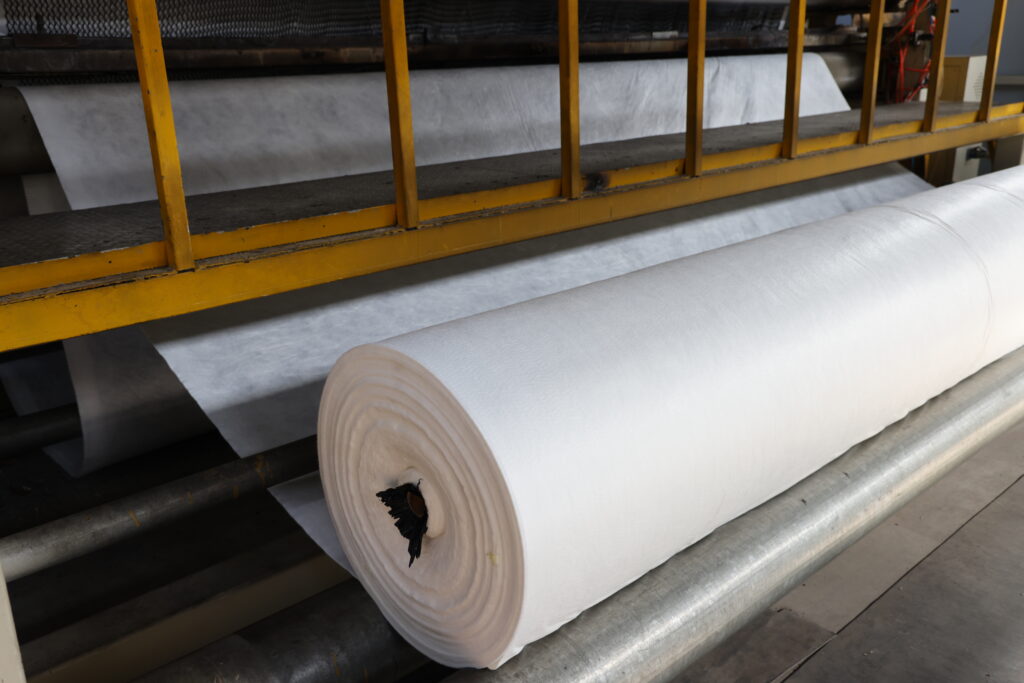Geotextile tensile strength test
Tensile strength testing of geotextiles is an important test used to evaluate their material properties, especially where they are widely used in geotechnical and civil engineering. This testing determines the strength and deformation characteristics of the geotextile under tensile loading to ensure it meets design and engineering requirements. The following are general steps for conducting tensile strength testing of geotextiles:
Sample preparation: Cut representative specimens from the geotextile. Test specimens are usually rectangular in shape and their dimensions shall be specified in accordance with the applicable standard or specification.
Testing equipment: Use a universal material testing machine or tensile testing machine to conduct the test. These devices allow the application of controlled tensile forces and measurement of the corresponding tensile deformations.
Clamp installation: Clamp the geotextile sample to the clamp of the testing machine, ensuring that both ends of the sample are evenly clamped so that it can remain stable during the stretching process. Make sure there is no looseness or friction between the clamps and specimen.
Set test parameters: According to the applicable standard or specification, set the test’s stretch rate (stretch speed), which is the stretch rate applied during the test. Usually, the stretching rate is expressed as the stretching speed per unit length or unit time.
Perform the test: Start the testing machine and gradually apply tensile force to stretch the geotextile specimen. Stress (force applied) and strain (tensile deformation of the specimen) data are recorded simultaneously. The tester will automatically stop before the specimen breaks.
Data Recording and Analysis: Once the test is complete, the recorded data can be used to calculate tensile strength (the maximum stress value) and elongation at break (the amount the specimen stretches before breaking). These data provide important information about the performance characteristics of geotextiles under tensile loading.
Report results: Based on the test results, a test report is generated, including tensile strength, elongation at break and other related parameters. These results can be used to evaluate whether the geotextile performance meets engineering requirements.
Please note that when conducting geotextile tensile strength testing, applicable standards or specifications should be followed to ensure test accuracy and comparability. This helps ensure the geotextile has the required strength and performance in engineering applications.

Geotextile tear strength test
The tear strength test of geotextiles is an important test used to evaluate their tear resistance, especially in civil engineering and geotechnical engineering. This test is designed to measure the strength and durability of geotextiles when subjected to vertical tearing forces. The following are general steps for conducting geotextile tear strength testing:
Sample preparation: Cut specimens from geotextiles that meet specification requirements. The specimen is usually rectangular or strip-like in shape, with specified dimensions and geometry.
Testing equipment: Use a universal material testing machine or tear testing machine for testing. These devices typically have fixtures and measuring devices suitable for tear testing.
Clamp installation: Clamp the geotextile sample to the clamp of the testing machine, ensuring that both ends of the sample are clamped evenly and the center of the sample is under the clamp. This ensures that the tearing force acts perpendicularly to the specimen.
Set test parameters: According to the applicable standard or specification, set the tear rate (tear speed) of the test, which is the speed at which the specimen will be attempted to tear during the test. Tear rate is usually expressed as speed per unit length or unit time.
Perform the test: Start the testing machine and begin applying vertical tear force in an attempt to tear the geotextile specimen. Stress (force applied) and tear distance (distance through which the specimen tears) data are also recorded. The test will stop when the specimen is completely torn.
Data recording and analysis: Once the test is complete, the recorded data can be used to calculate tear strength, usually expressed as force per unit width, and tear distance. These data provide information on the tear resistance of geotextiles.
Report results: Generate test reports including tear strength and other relevant parameters. These results can be used to evaluate whether the tear performance of geotextiles meets engineering requirements.
Please note that when conducting geotextile tear strength testing, applicable standards or specifications should be followed to ensure test accuracy and comparability. This helps ensure that the geotextile has the required tear resistance properties in engineering applications.

